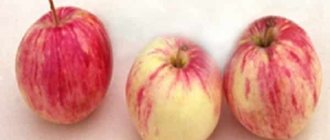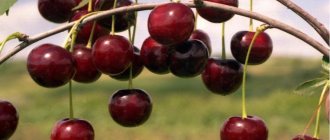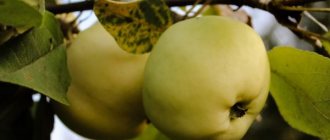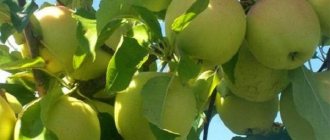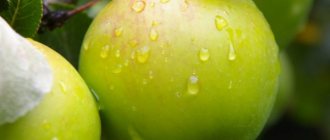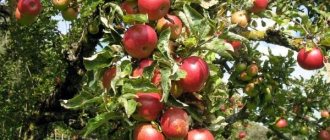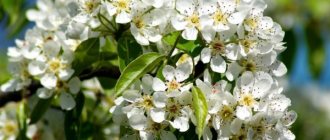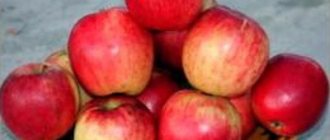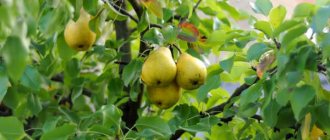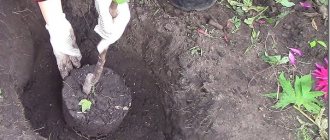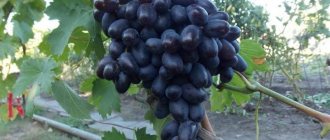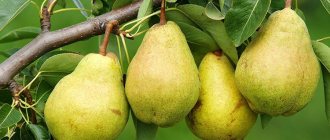The expanses of a large country have a varied climate, and gardeners in different regions want to grow apple trees that would produce a good harvest, and the fruits on them would be of high quality. Breeders do a good job with the task assigned to them. Spartak is an apple tree bred at the Samara experimental station for the Volga region, where weather conditions vary from hot summers to rather cold winters.
Apple variety Spartak.
External description
The tree is medium-sized. The bark of the plant is brown. The branches extend from the trunk at an acute angle, which often causes fractures. Therefore, the plant needs regular crown formation. The shoots are smooth, brown-red, straight.
Apple tree height
The height of the tree grows no more than 6 meters. The crown of the plant is wide, dense, rounded-pyramidal.
Leaves
The leaf blades of the crop are green in color, wavy, narrowed at the base. The leaves are oval-oblong. The tip is twisted and elongated. The reverse side of the leaves is slightly pubescent.
Fruits of the tree
Main characteristics of the fruits of the crop:
- medium sized fruits;
- weight 90-130 grams;
- there are large specimens weighing 300 g;
- round shape;
- the peel is shiny, medium thickness, strong;
- yellow in color with bright red merging stripes;
- the stalk is medium in length;
- medium sized cup;
- seed nest is bulbous, medium size;
- the pulp is fine-grained, medium in density, tender;
- the taste is sweet and sour.
Technical maturity occurs at the end of summer or in the first ten days of September. Consumer and commercial properties are high. Spartak apples are intended for table use. Suitable for fresh consumption, for juice production and for culinary purposes.
Root system
The root system of the crop is strong and powerful. When purchasing, you should choose plants with roots no longer than 40 centimeters.
Rootstocks
The Spartak apple tree variety is grown on various rootstocks. Summer residents often confuse a columnar apple tree with a dwarf one. To avoid mistakes when buying plants, you should understand the differences.
On a dwarf rootstock
The culture is low growing. An adult plant reaches a height of 3 meters. It has a spreading crown. Advantages:
- ease of care;
- decorative appearance;
- precociousness;
Thanks to the root system located near the soil surface, the crop is suitable for areas where groundwater is close to the ground.
Columnar
The main feature of the plant is its appearance. The culture has one strong standard. The lateral fruit branches are short. The fruits are located along the trunk - this helps to save space on the site and, if necessary, plant more fruit trees.
Benefits of culture:
- the plant bears fruit from the first year;
- gives a high yield;
- frost resistance.
The disadvantages include a short fruiting period. The crop produces a high-quality harvest for only 15 years, after which the tree is replaced with another.
Ripening and fruiting
A high yield and some fruiting characteristics that you need to become familiar with will be useful in order to collect the fruits on time and preserve them longer.
Beginning of fruiting
Spartak is a fast-bearing apple tree; fruiting begins 3-4 years after planting. On a dwarf rootstock, the first fruits appear even earlier.
Peculiarity
This variety has rapid shoot formation and high bud awakening, so the apple tree bears fruit every year.
Ripe fruits.
Deadlines
The Spartak apple variety begins to ripen in early September. But the fruits do not all ripen at the same time, so the harvest lasts 2-3 weeks.
Maturation
The normal color of apples is yellowish-green, with a slight red blush, but as soon as the blush on the fruit turns bright red and covers them completely, this is the best time to pick.
Fruit storage and harvesting
Apples can be stored for up to two months without losing their taste and tolerate transportation well. With high yields, gardeners are advised to process the fruits in a short time. After two months of storage, apples begin to taste bitter.
Characteristics of Spartak apple trees
When purchasing high-quality planting material, the tree bears fruit from the 4th year. The plant is recommended for cultivation in areas with cold climatic conditions.
Features of crown formation
The crown of the plant is dense. Branches constantly and rapidly grow at different angles, which leads to their breaking. Therefore, the crop needs to constantly form a crown.
See also
Description and characteristics of the apple tree variety Scarlet Flower, productivity and winter hardinessRead
Flower pollination
The culture belongs to self-pollinating varieties. Cross pollination is required for better fruit set.
Fruit
The fruits are juicy and strong. They have high taste qualities. Apples make delicious jam.
Harvest characteristics
Spartak is a high-yielding plant. An adult tree pleases gardeners with a bountiful harvest, which in a fertile year is about 100 kilograms.
How the Spartak apple tree tolerates low temperatures
The frost resistance of the crop is average. Requires proper care. When the temperature drops to -25 ° C it freezes.
Diseases and pests
Possible ailments:
- Scab. Usually appears in unfavorable years with heavy rains. The disease spreads through the foliage and bark of the crop.
- Cases of plant disease with cytosporosis and fruit rot are rare.
With timely preventive measures, the risk of plant diseases is reduced to zero.
Taste qualities
Experts highly appreciate the taste of apples. On a 5-point scale they were assigned 4.5 points.
Composition of vitamins and microelements in the Spartak apple
Includes:
- copper;
- potassium;
- Apple acid;
- chlorine;
- wine acid;
- nickel;
- iron;
- lemon acid;
- manganese;
- chlorogenic acid;
- ursulic acid;
- calcium;
- cobalt;
- molybdenum;
- valeric acid;
- magnesium;
- iodine;
- propionic acid;
- zinc;
- isobutyric acid;
- vanadium;
- phosphorus;
- unsaturated fatty acids;
- boron;
- rubidium;
- vitamins (A, C, E, K, H);
- fluorine;
- aluminum;
- sodium;
- vitamins B (1, 2, 3, 5, 6, 9);
- chromium;
- sulfur.
Depending on the area where the crop grows and climatic conditions, the amount of microelements and vitamins contained in fruits varies.
Spartak apples: features of the variety
Advantages and disadvantages.
Advantages: the variety is early-bearing, the fruits have high marketability and good taste, the yield indicator is decent and stable.
Cons: low resistance to diseases such as scab.
The size of an adult apple tree.
Tree of weak growth vigor. An adult apple tree reaches a height of five to six meters.
Self-fertility.
The variety is self-pollinating. However, cross-pollination is required for better fruit set.
Yield indicator.
The variety brings high yields. One mature apple tree produces more than one hundred kg of fruit.
Tasting assessment.
The fruits weigh between one hundred and twenty to two hundred grams. They are round, cone-shaped, ribbed at the top. The peel is light green in color, a blurry blush covers the entire surface, and there is also a waxy coating on the skin. The internal contents of apples are dense, white in color, and have a pleasant sweet-sour taste.
The tasting score was four and a half points out of five.
Resistance to the winter season.
Frost resistance is at an average level. If you do not take care of the apple tree, it can freeze at low temperature conditions of twenty-five degrees.
Immunity to diseases.
In some years with a lot of rain, the leaves and bark may become scabbed.
Fruit rot and cytosporosis affect apple trees in rare cases.
Planting seedlings
Before purchasing planting material, it is necessary to study in detail the rules and methods of planting.
Landing in the ground
Before digging a planting hole, it is necessary to thoroughly clear the space of weeds, pebbles and stumps. The place will need to be well lit and protected from the winds, and the groundwater should be deep.
Choosing seedlings
The key to productivity is properly selected planting material. When purchasing crops, pay attention to:
- Root system. It must be well developed. The length of the roots is no more than 40 centimeters and no less than 35 centimeters.
- The thickness of the stem, which ranges from 2 to 2.5 centimeters.
- Branches. Their number should be 1-3. Length about 50 centimeters.
- The height of the trunk. The ideal size is 80-90 centimeters.
- Age. Two-year-olds take root best and bear fruit faster.
After selecting seedlings, it is necessary to plant them correctly and provide proper care.
Deciding on the landing site
The culture is unpretentious to soils. Grows equally well in different regions. In order for a young tree to develop properly and gain growth vigor, it needs to be fed regularly.
At what distance should seedlings be planted?
Before planting, take into account the crown of an adult plant. In order for the apple tree to receive a sufficient amount of light and nutrients throughout its life, it is necessary to plant crops at a distance of 5 meters from each other.
Landing dates
Planting is allowed twice a year: in autumn and spring. If the region is characterized by early autumn frosts, then planting work is recommended to be carried out in the spring, before the buds open.
In autumn, the crop is planted in the ground after all the foliage on the trees has fallen, but before frost sets in.
Tree morphology and apple properties
The Kutuzovets apple tree received the following morphological characteristics from its predecessors:
| Tree height and vigor | 3-4 m (medium height) |
| Bark coloring | Brown-green (trunk and skeletal branches), light brown in young shoots |
| Crown shape | Flat-round |
| Crown density | Average |
| Tree spreading | High (skeletal branches form almost a right angle with the trunk) |
| The power of skeletal branches | High |
| foliage | Weak |
| Leaves | Glossy, small in size, rich dark green color, elongated oval shape, curved tip, pubescent lower part |
| Flowers | Small, light pink |
| Fruit formation | Rings (in an adult tree), spears and twigs |
The Kutuzovets apple tree lives quite a long time - up to 60 years or more. The phase of full fruiting begins at approximately 6–8 years of age (which is considered a rather late start) and lasts about two decades, however, with proper care and timely rejuvenation of the crown, both of these periods can be significantly extended.
Important! Sometimes inexperienced gardeners worry about the lack of foliage of Kutuzovets. In fact, this property of the variety only contributes to more active pollination: intensive leaf blossoming begins not before, but after the tree blooms.
As for the apples themselves, you need to know the following about them:
As for the apples themselves, you need to know the following about them:
| Form | Round with slight horizontal expansion. There is wide ribbing |
| Dimensions | Identical, quite large, up to 160 g |
| Skin color | Green or yellowish, at the stage of biological ripeness there may be a blurry pink “marbled” blush. There are many subcutaneous points. |
| Skin structure | Not too dense, quite soft |
| Funnel | Varying degrees of depth, golden color with a transition to brown along the edges |
| Saucer | Small, with slight ribbing |
| Pulp | Light green or white, very juicy, dense, breaks with a crunch when bitten |
| Seeds | Small, located in tightly closed chambers |
| Taste | Sweet and sour, similar to Simirenko, with a faint spicy aftertaste |
| Tasting rating (five-point scale) | 4 points |
Step by step landing process
To make the plant take root faster, follow simple recommendations when planting:
- Dig a hole in 3 weeks. The minimum size in width and depth is 70 centimeters.
- Mix the top layer of soil with compost and humus. Pour into the hole and fill with 30 liters of water. Cover with film.
- After 3-4 weeks, make a depression in the center the size of the plant’s root system. Fill with 15 liters of water.
- Spread out the roots. This will help the plant develop better. Place into the prepared hole.
- The root collar should be 6 centimeters above the soil level. Thoroughly bury the roots and compact the soil.
- Make a hole near the trunk. This will help improve watering on hot days.
- Drive a peg next to the plant and tie a seedling to it. Such an event will help the tree to hold firmly and withstand the winds.
See also
Description of the Carpet Apple tree variety, main characteristics and cultivationRead
The crop is watered abundantly and the tree trunk circle is mulched.
Protection against insects using traditional methods
Apple tree July Chernenko
To combat parasites, it is not recommended to use chemicals that negatively affect the quality and composition of fruits. Here are gardener-tested and effective folk methods to kill insects:
- Black henbane actively helps in the fight against herbivorous bugs and aphids. To prepare the product you will need 1 kg of dried herb and 3 liters of water. The resulting composition is boiled over low heat for at least 1 hour. Next, the broth is cooled, diluted with water so that the total volume is 10 liters and poured into a spray bottle to irrigate the tree.
- Cool boiling water helps get rid of ants; just water them in their habitat.
- A decoction of tomato tops can effectively deal with caterpillars and leaf-eating insects. To prepare, you will need 1 kg of tomato tops, pour 10 liters of water and leave for at least 5 hours. The resulting composition is simmered over low heat for at least 3 hours and more water is added 3 times more than the available volume. Once the solution has cooled, you can begin processing the orchard.
Important! Diseases are always easier to prevent than to treat. A similar pattern applies to insects. If you identify them at the initial stage of the lesion, then the likelihood of overcoming them with minimal time and financial costs increases significantly.
Harvest
How to grow an apple tree
During the first few years, crop care consists of several steps that must be strictly followed to obtain a bountiful harvest.
Tree care
Regularly monitor the cleanliness around the plant. Weeds take away heat and light from apple trees, so they must be removed in a timely manner.
Due to the average winter hardiness, care is taken to ensure that the crop remains alive after the winter period.
After the temperature drops below +15 °C, the tree trunk circle is mulched with a layer of humus. It helps retain heat and does not release it from the ground. The trunk of the tree is covered with mineral material.
Pruning and crown formation
Formative pruning is carried out during the first three years. Remove branches growing at right angles. From the age of 4, only weak and dried parts are pruned. The procedure helps to rejuvenate the crop and makes it possible to obtain abundant harvests of large fruits.
Care during flowering
During flowering, regularly inspect for the presence of pests. If found, remove them manually. It is not recommended to spray with chemicals, as they harm beneficial insects that pollinate plants.
Watering
Watering the crop should be regular. Carry out 4 times a month.
Protection from diseases and pests
For prevention:
- planted on hills;
- the crown is regularly thinned for air circulation;
- in the autumn, they dig up the tree trunk circle;
- in spring they make a pest trap;
- The crop is regularly sprayed with special preparations.
If you follow simple recommendations, the plant will grow strong and healthy.
Fertilizing the apple tree
The best fertilizer is horse manure, which is recommended to be fed 3 times per season.
Pollinator varieties
To increase the number of ovaries, pollinating apple trees are planted nearby:
- Umanskoe;
- Idared;
- Ruby Dookie.
Without pollinators, only 30% of ovaries are formed.
Fruiting time
Bears fruit from 3-4 years. Refers to precocious.
Selection
The first apples of the Spartak variety were produced in 1945. The culture originated from the Skryzhapel and Sharopai apple trees.
Features of apple tree care
Caring for an apple tree of the Zhigulevskoye variety is not difficult, but it still requires some standard procedures. These primarily include watering, regular pruning, fertilizing, as well as preventive treatment of the tree.
Watering
Mature fruit trees, unlike annual garden crops, do not need frequent watering; moreover, such procedures can lead to rotting of the roots. Therefore, you need to water the apple tree in the spring, when the sun warms up (if the winter was not snowy and the soil has dried out), during the period when active fruit set begins, and in late autumn, in order to prevent the roots from freezing.
Important! The most common mistake of inexperienced gardeners is regular but meager watering of trees. In fact, you need to do the opposite: if the root system is rarely saturated with moisture, the amount of water should be significant - from 30 to 80 liters, depending on the age of the tree and the condition of the soil.
For young seedlings that have not yet developed a sufficiently powerful root system, drought can be a serious problem, so during a particularly hot summer period the tree needs to be watered periodically, guided by the mentioned rule regarding the volume of water used
For young seedlings that have not yet developed a sufficiently powerful root system, drought can be a serious problem, so during a particularly hot summer period, the tree needs to be watered periodically, guided by the mentioned rule regarding the volume of water used.
In order to retain moisture in the soil longer, it is recommended to mulch the tree trunk circle with peat, straw, sawdust or bark, or plant nearby vegetable crops with a shallow root system, such as beans or peas.
Such procedures also have an additional goal - to prevent contamination of the soil at the foot of the seedling by weeds, which are potential carriers of various diseases and pests.
Trimming
As already mentioned, the Zhigulevskoye tree never grows too densely with branches. Its shoots, as a rule, are few in number, straight and directed upward, so pruning such an apple tree can be done without much effort. However, such a procedure is still necessary throughout the entire life of the tree, since it is this that ensures the regularity, volume and duration of fruiting.
Important! An apple tree, unlike a pear and plum tree, should not be shortened immediately after planting. Starting from the second year of the seedling’s life, they begin to form a trunk and skeletal branches in a permanent place
Starting from the second year of the seedling’s life, they begin to form a trunk and skeletal branches in a permanent place.
The essence of this work is:
- removing branches that interfere with each other (growing close and directed in one direction or intersecting);
- removing branches growing at an acute angle to the trunk;
- slight shortening (pinching) of the main shoots;
- shortening all other branches by 1/3.
The best time for formative pruning is early spring, before the buds awaken. This period can be combined with sanitary pruning, which involves removing dried, broken or disease-damaged branches.
To improve the fruiting of an old apple tree, so-called anti-aging pruning is used. There are several methods for carrying it out, the simplest is to sequentially shorten all branches of the tree to the same length.
Apple tree fertilizer
The main rule in the process of fertilizing fruit trees is moderation. If the soil mixture was prepared correctly when planting the seedling, the nutrients it contains will be enough for the tree to last for the first 2–3 years of its life.
In the future, fertilizing is carried out with the same frequency - once every 2-3 years - and according to the following scheme:
| Type of fertilizer | Deadlines for depositing | Examples of preparations and application rates |
| Nitrogen | Spring | Urea - 600 g, ammonium nitrate - 40 g |
| Potassium | Summer or autumn | Potassium sulfate - 70 g |
| Phosphorus | Autumn | Superphosphate - 30–40 g |
| Organic | Spring, summer or autumn | Humus - 30–40 l |
In addition to root feeding, during the active growing season you can also spray the apple tree with preparations containing iron, zinc, boron, and magnesium. However, it should be remembered that before applying fertilizer, regardless of how it is carried out, the tree must be watered abundantly.
Harvest and storage
Fruits are picked when their surface turns an intense red hue. If the stripes stand out strongly, it means the apples need to hang for a couple more weeks.
Harvesting
The fruits ripen unevenly. You can enjoy the first specimens in early September. The remaining ones ripen for about 3 more weeks.
Fruit storage
The fruits retain their marketable and transportable appearance for 2 months. After this, their condition worsens significantly, but apples are suitable for food until February.
Usage
The fruits are suitable for:
- fresh consumption;
- canning;
- juice production;
- culinary purposes.
Nuances and questions from readers
What is the difference between the varieties Spartak and Spartan?
To answer this question, we turned to gardening experts. This is what they told us: “Despite the fact that there are some similarities between the apple trees, there is still a visual difference. Thus, the central conductor of the Spartan apple tree has a strong slope, and the dark cherry-colored shoots are lowered to the bottom.
Apple tree Spartan.
The foliage of the tree also differs from the Spartak variety in its small size and peculiar twist. Although the fruits of apple trees are similar in appearance, in the Spartan variety they have a more intense color and purple hue, as well as a fairly long shelf life.”
To help the gardener
There are nuances in the rules for growing crops in different regions.
Geography of variety cultivation
Due to its drought resistance and ability to tolerate heat and cold, it is suitable for many climate zones.
Moscow region
In order for the seedlings to take root better, they are whitened with lime twice a year. For the winter period, be sure to cover and mulch the space around the trunk.
Central Russia
In this region, the plant is often affected by scab. To prevent the disease, the crop is treated with fungicides.
If the trunk is damaged by rodents, the damaged areas are disinfected with iron sulfate.
Southern regions
To make the tree take root better, fertilize it with a solution of sodium fertilizer and urea. Based on the characteristics of the soil in a given region, to prevent fracture of the central conductor, a support is built that does not allow the plant to sag.
Ural
The soil of the Urals is strong and hard. Therefore, the aeration of the roots of the crop is increased. Several times a season, the space around the trunk is loosened and the top layer of soil is broken up.
In the Kirov region
To improve the properties of the soil, the tree trunk circle is sown with creeping bentgrass. To avoid drying out of the soil, compost and humus are placed around the apple tree.
Other regions
In other regions, caring for the crop does not require additional recommendations and does not differ from caring for other fruit crops.
Growing in regions
In outskirts of Moscow
For good survival of the Spartak apple tree in the Moscow region, it is necessary to whiten the tree trunk with lime 2 times a year .
In the fall, it is advisable to carry out protective work that will prevent the apple tree from freezing in the winter.
To do this, the tree trunk circle should be mulched with humus, and the tree itself should be covered with roofing felt or burlap.
In central Russia
The Spartak apple tree has all the necessary characteristics of the variety for successful growth in the Moscow region. However, in this region the plant is often subject to scab . In order to prevent this disease, it is necessary to spray the tree with fungicides.
Advice! If the apple tree was damaged by rodents in winter, in the spring you need to clean the damaged areas and disinfect them with iron sulfate.
In the Southern regions
For good survival of the Spartan variety in the southern regions of Russia, the young seedling needs feeding with a solution of urea and sodium fertilizers.
To avoid breaking the central conductor when the soil settles, which is so typical for this region, you need to build a support that will not allow the tree to sag.
In the Urals
The soil in the Urals is quite hard. In order for the seedling to take root well in this region, it is necessary to increase the aeration of the roots.
To do this, the tree trunk circle is intensively loosened several times a season , breaking up the top layer of soil.
Timely inspection of the tree will also help identify scab and other fungal diseases.
In the Kirov region
When growing a Spartak apple tree in the Kirov region, you need to take into account the structure of the earth. To improve the physical properties of the soil, the area near the tree trunk is sown with creeping bentgrass. To prevent the soil from drying out, humus and compost are spread around the trunk.
